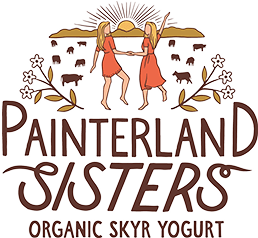What is organic farming? Does buying organic truly make a difference?
If you have been exploring the world of organic farming and foods, you've probably been wondering these very questions. We understand-there is a LOT of information out there. How do you know what to look for, which sources to trust, and what is best for the health of you and your family?
Knowledge is power, and at Painterland Sisters, one of our goals is to educate people like you on the benefits of organic farming. Let's start with the basics.
Types of Organic Labels
First, it's important to understand the difference between the three types of organic labeling you'll see at the story.
USDA-Certified Organic
As you shop for groceries, you will also see other products with the "USDA Organic" seal.
This seal certifies that the U.S. government has worked with the National Organic Program to guarantee that the product passes federal regulations for organic standards. The USDA regulates the growth and processing of every product, from the land that is used to the plants and animals that are grown and harvested to the processing techniques, tools, and ingredients used with those products.
Every certified organic product is monitored, regulated, and approved at every step, from the land to the time it reaches your shopping cart. This seal means the federal government has declared the producer's products as organic.
Made with Organic Ingredients
You may also see packaged products with the label "made with organic [specific ingredient or food group]," which means they contain at least 70% organically produced ingredients. The remaining non-organic ingredients are produced without prohibited practices (e.g., genetic engineering), but can include substances that are not allowed in 100% organic products.
Products with this label will not contain the USDA organic seal, but must still identify the USDA-accredited certifier. You can look for the certifier on a packaged product for verification that the organic product meets USDA's organic requirements.
Non-certified Organic
Finally, some products may simply use the word "organic" on their products. These claims are not regulated or verified by the government.
Next, we'll look at how organic farming and operations work.
Organic Farming Definitions
The USDA organic regulations require that a USDA-accredited certifying agent verify a producer's operations and products before they can be labeled as organic. Organic operations must demonstrate that they are:
- Protecting natural resources;
- Conserving biodiversity; and
- Using only approved crop, livestock, and processing inputs.
Organic Crop Farming
Organic crop farming is an agricultural system that uses natural pest control and fertilization methods, including cover cropping, crop rotation, and animal and plant waste.
Organic systems focus on healthy food, soil, plants, and environments as well as crop productivity. A key step of this is increasing organic soil matter (i.e., bacteria, fungi, and other microorganisms), which helps to:
- Enhance the soil's ability to absorb water, reducing the impacts of drought and flooding.
- Absorb and store carbon and other nutrients needed to grow healthy crops, which are better able to resist insects and diseases.
Simply put, the more organic matter, the healthier the soil!
Organic Animal Agriculture
Organic animal agriculture requires certified organic livestock, proper land management to keep pastures organic, and freedom for the animals to graze on open pastures. Both the certified organic livestock farm and the processing facilities used are inspected by a National Organic Program-accredited certifying agent at least once a year.
Organic livestock farming focuses on healthy, organic living conditions for the animals. This means accommodating the animals' natural behaviors and supporting its health and welfare. They must be free to graze for the entire grazing season, which must be at least 120 days a year, and receive at least 30% of their nutrition from pasture. This system helps to:
- Foster healthy land by maintaining soil fertility and minimizing erosion and creating boundaries to prevent prohibited substances from permeating the organic fields.
- Raise healthier, happier animals that live longer lives and produce clean, nutritious food.
Organic Processing
Organic products must be processed in a plant that uses strict sanitation practices necessary to prevent cross-contamination of organic and non-organic material. Any contact with non-organic products during the production process is considered contamination.
According to USDA regulations, organic food must not contain any artificial preservatives, colors, or flavors (with very few exceptions). This is why organic products sometimes have a shorter shelf life than non-organic items. In the case of multi-ingredient organic products, a minimum of 95% of the product must contain certified organic ingredients.
Next, we'll take a look at the many benefits of organic farming to gain an even better understanding of how it all works.




